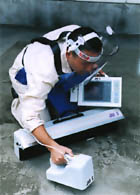 |
 |
 |
 |
 |
 |
|||||
 |
 |
 |
 |
|
CLEARING LANDMINES: New Detector Promises Safety and Efficiency June 29, 1999  The new mine detector should make the life-saving work quicker and easier. (Japan Alliance for Humanitarian Demining Support) A Japanese nonprofit organization has developed a revolutionary new system for detecting antipersonnel landmines in an accurate and speedy manner. The new detector uses electromagnetic waves to give a precise image of these mines, including their position, composition, and shape. As a result, it promises to greatly increase the safety and efficiency of demining work. At present there are said to be more than 110 million landmines buried around the world. These landmines result in the deaths and injuries not only of residents but also demining workers, so great expectations are being placed on the new detector. Zeroing In on Landmines At present only metal detectors are used for demining. Much work is consequently wasted because the detectors respond to all metal objects and also because they do not react to plastic mines. In contrast, the new system can confirm the position and shape of an object in the ground; if it is a landmine, workers can dispose of it with a separate device without any digging. So the efficiency and safety of demining work can be significantly enhanced. JAHDS was founded in March 1998 with the support of several private firms, including Secom Co., Omron Corp., and IBM Japan. Its purposes are to develop and promote landmine detection and demining technology and to provide overall humanitarian support in the form of technical expertise, medical aid, and the facilities and equipment needed for transportation, communication, and housing. Toyota Motor Corp., Honda Motor Co., and Nippon Iridium Corp. have offered to supply these necessities. In developing the new detector, JAHDS and cooperating firms applied void detection technology, which is used in surveys of road subsidence. JAHDS plans to conduct final tests in Cambodia from July 1999 in cooperation with a British NGO and local demining organizations before commencing mass production of the detectors by the end of the year. Halting the Use of Landmines As a result, the number of victims has been rising. According to the International Committee of the Red Cross and the United Nations, about 26,000 people die or are injured by landmines every year, and there are an estimated 250,000 persons around the world today who have been maimed in an explosion. Furthermore, with the frequent outbreak of ethnic conflicts since the end of the cold war, and the resulting use of mines in more populated areas, the victims are almost always civilians: farmers, elderly persons, women, and children. In the face of these tragic developments, there has been a surge of international opinion calling for a complete ban on landmines, including their production, stockpiling, and use. At a signing ceremony in Ottawa in December 1997, 121 countries and territories, including Japan, signed the Total Ban Treaty on Anti-Personnel Mines, and countries around the world launched an effort toward complete eradication. As a pacifist nation, Japan in particular is expected to play a prominent role in this campaign. The development of the new detector will likely attract much praise as part of such an effort.  Edited
by Japan Echo Inc. based on domestic Japanese news sources. Articles presented
here are offered for reference purposes and do not necessarily represent
the policy or views of the Japanese Government. Edited
by Japan Echo Inc. based on domestic Japanese news sources. Articles presented
here are offered for reference purposes and do not necessarily represent
the policy or views of the Japanese Government.
|

